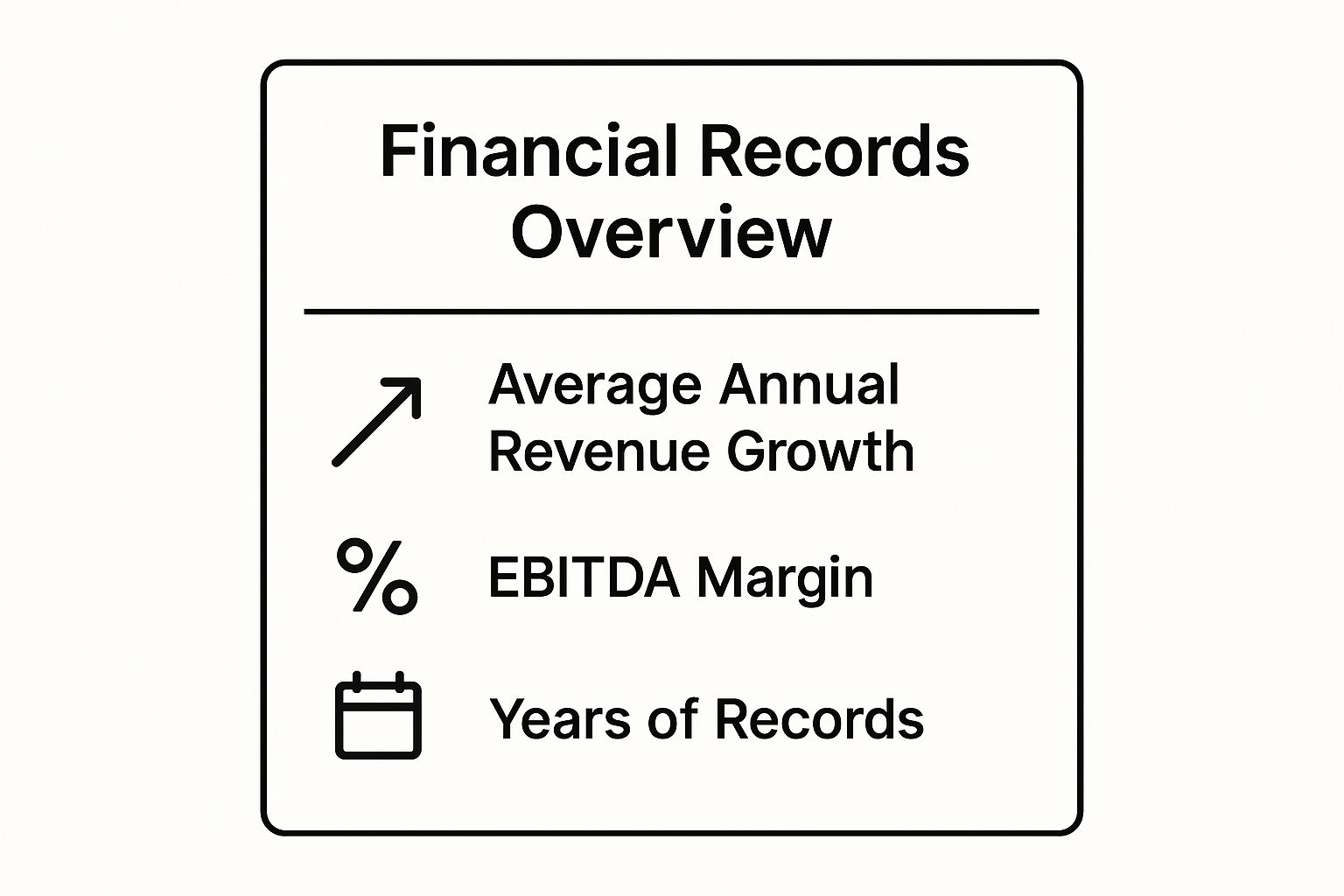
Buying a business is one of the most significant financial decisions you'll ever make. It's a complex process filled with excitement, potential, and plenty of risk. While the numbers on a profit and loss statement tell part of the story, they don't reveal everything. The true value, and the hidden dangers, of an acquisition lies in the answers to the right questions. Asking superficial questions can lead to costly surprises, while a thorough inquiry can uncover opportunities and protect your investment.
This guide provides a comprehensive checklist of the most critical questions to ask when buying a business, moving beyond basic financials to explore operational stability, market position, and future growth potential. Think of it as your due diligence blueprint. We'll delve into the seller's motivations, dissect financial health, clarify what's included in the sale, and examine legal obligations.
By methodically working through these areas, you'll build a complete picture of the enterprise. This allows you to negotiate effectively, secure financing, and confidently take the helm of your new venture. This isn't just a list; it's your roadmap to a successful acquisition, ensuring you look beyond the bottom line to see the full picture.
This is often the first and most critical of all the questions to ask when buying a business. The seller's answer provides a fundamental context for your entire due diligence process, revealing potential red flags or confirming a genuine opportunity. Legitimate reasons like retirement, health issues, or a desire to pursue other ventures are common. However, the real motivation might be masked, pointing to deeper issues.

Understanding the "why" helps you assess the true health and future viability of the company. A seller exiting because of burnout presents a different scenario than one leaving because a major client contract is about to expire, or a disruptive competitor is entering the market.
A straightforward answer is a good start, but verification is key. You must dig deeper to ensure the stated reason aligns with the business's reality.
"The seller's reason for leaving is the foundation of the story you're being sold. Your job is to read between the lines and verify every chapter of that story with hard data."
Beyond the seller's story, the numbers tell the unbiased truth. Requesting comprehensive financial documentation for the last three to five years is a non-negotiable step in your due diligence. These records, including tax returns, profit and loss statements, balance sheets, and cash flow statements, are the bedrock of your business valuation and risk assessment.

Analyzing these documents reveals the company's genuine financial health, identifies trends, and highlights potential for future profitability. A seller's reluctance to provide transparent financials is a major red flag, suggesting that you are essentially buying blind.
A pristine P&L statement is great, but it must be corroborated by other official documents. Your goal is to verify the numbers and understand the story they tell about the business's stability and operational efficiency.
"Financial statements are the business's report card. Tax returns are the government-verified transcript. Always demand both, and hire a professional to grade them."
Among the most important questions to ask when buying a business, this one defines the very substance of your purchase. A vague understanding of the assets, liabilities, and terms can lead to costly surprises post-acquisition. The sale price means nothing until you know exactly what tangible and intangible assets you are acquiring, from physical equipment and inventory to intellectual property and customer contracts.

Defining these components prevents future disputes and ensures you have everything needed to operate from day one. It clarifies whether you're buying assets or the company's stock, which has significant tax and liability implications, and sets the stage for structuring the deal's financing.
Never assume anything is included. The purchase agreement must explicitly list every asset, liability, and condition of the sale. Clarity here protects both buyer and seller.
"The deal is in the details. The 'what' defines the value you're receiving, and the 'how' dictates the price you'll actually pay. Get both in writing, without ambiguity."
A business is more than its assets and revenue; it's a complex web of legal commitments. This question forces a deep dive into the contracts, leases, and agreements that dictate its operations, profitability, and future flexibility. These documents can either be hidden assets or significant liabilities waiting to surface after the deal is done.
Understanding these obligations is crucial for assessing ongoing costs, identifying transferability issues, and uncovering potential risks. A favorable long-term lease can be a major source of value, while an unfavorable supplier contract could drain cash flow for years. This is a non-negotiable step in your due diligence.
Simply getting a list of contracts isn't enough. You and your attorney must meticulously review each document to understand its terms and implications for a new owner.
"Every contract tells a story about the business's past relationships and future obligations. Your job is to ensure you're not inheriting a story with a bad ending you'll be forced to pay for."
Beyond the financials, a business is its people. This question is crucial because the skills, knowledge, and customer relationships held by key employees often represent a significant portion of the company's intangible value. A business heavily reliant on the owner or a single "star" employee carries substantial risk that you will inherit upon purchase.

Understanding the organizational chart, roles, and dependencies helps you gauge the business's operational stability post-transition. You need to know if the company's success is embedded in its systems and broader team or concentrated in a few individuals who could walk out the door, taking their value with them.
You must look past the formal org chart to see how the business truly functions. Identifying dependencies and assessing the team's loyalty and capabilities are essential parts of your due diligence.
"You're not just buying assets and a brand; you're buying a team and the knowledge they possess. If that knowledge isn't documented or transferable, its value disappears the moment key employees leave."
A business is nothing without its customers, making this one of the most vital questions to ask when buying a business. Understanding who the customers are, how they behave, and how much they contribute reveals the true stability and growth potential of the company's revenue streams. A loyal, diversified customer base is a powerful asset, while over-reliance on a few key clients is a significant liability.
Analyzing the customer portfolio helps you assess market risk, revenue predictability, and the strength of the business's relationships. It distinguishes between a company with sustainable, recurring income and one whose revenue could vanish overnight if a single client leaves.
A seller will often highlight their best customers, but you need a complete, unbiased picture of the entire customer landscape to identify potential weaknesses.
"Revenue stability isn't just about the total dollar amount; it's about the quality and diversity of its sources. A business with 1,000 small, loyal customers is often far more secure than one with three large ones."
Understanding where the business stands in its industry is just as important as scrutinizing its financials. This question forces you to look beyond the company’s internal operations and evaluate its external environment. A business with a strong, defensible market position is far more likely to sustain profitability and weather economic shifts than one struggling in a saturated, commoditized market.
Assessing the competitive landscape reveals the business’s unique value proposition, potential threats, and opportunities for growth. A company might look profitable today, but if powerful competitors are entering the market or technological shifts are making its offerings obsolete, that profitability is at high risk. This analysis is fundamental to forecasting the business's long-term viability.
A seller will naturally highlight the business's strengths, but you must independently verify its market standing. Your due diligence should focus on validating their claims against objective market data and competitive intelligence.
"Profitability is temporary, but a strong competitive advantage is durable. Never buy a business without first understanding what protects it from being driven into the ground by competitors."
Beyond the current state of the business, your return on investment hinges on its future potential. This is a critical question to ask when buying a business because it forces you to look forward, assessing both untapped potential and potential roadblocks. A business that has plateaued presents a very different financial future than one with clear, achievable growth levers.
Understanding the landscape of opportunities and obstacles allows you to validate the asking price and formulate a post-acquisition strategy. It helps determine if the business's future aligns with your personal goals, capital, and skill set, distinguishing a good business from a good investment for you.
A seller will naturally highlight opportunities, but you must independently verify their viability and understand the associated challenges. The goal is to separate realistic potential from speculative fantasy.
"Every business has 'potential.' Your job is to calculate the real cost, time, and risk required to unlock it. The best opportunities are often the ones the current owner was too busy, tired, or risk-averse to pursue."
| Aspect | Why Is the Current Owner Selling the Business? | What Are the Complete Financial Records for the Past 3-5 Years? | What Is Included in the Sale and What Are the Terms? | What Are the Current Contracts, Leases, and Legal Obligations? | Who Are the Key Employees and What Is the Organizational Structure? | What Is the Customer Base and How Stable Is Revenue? |
|---|---|---|---|---|---|---|
| Implementation Complexity 🔄 | Low to Medium: Requires sensitive questioning and verification | High: Involves gathering extensive documents and accounting expertise | Medium to High: Needs detailed legal and asset review | High: Legal review of multiple contracts often required | Medium: Employee interviews and org chart analysis | Medium: Data collection and customer analysis required |
| Resource Requirements ⚡ | Low: Mainly time and communication skills | High: Requires CPA/accountant, detailed document review | Medium: Legal advisors and appraisers needed | High: Legal expertise and time-consuming contract reviews | Medium: HR/admin resources and possible interviews | Medium: CRM data, analytical tools, and customer feedback |
| Expected Outcomes 📊 | Identify seller motivation, potential red flags or opportunities | Accurate financial health assessment, valuation, risk identification | Clear understanding of sale scope, asset/liability inclusion | Awareness of ongoing obligations, risks, and transferability | Insight on critical personnel, continuity risks, and culture | Understand revenue stability, customer risks, and growth potential |
| Ideal Use Cases 💡 | Early-stage due diligence to assess seller credibility | Financial due diligence before valuation and financing | Before finalizing purchase agreement to avoid post-sale issues | Prior to closing to assess legal and operational commitments | When people are key to business success and continuity | To evaluate revenue reliability and customer concentration risks |
| Key Advantages ⭐ | Reveals hidden issues, negotiation leverage | Foundation for valuation and financial planning | Prevents misunderstandings, clarifies buyer’s actual acquisition | Identifies fixed costs and liabilities, legal risk management | Helps plan employee retention and transition | Predicts revenue sustainability, highlights customer risks |
| Key Challenges 🔄 | Seller transparency varies, may require cross-verification | May have incomplete or mixed records, requires expertise | Complex negotiations, tax implications, asset disputes | May expose unfavorable or untransferable contracts | Retention risk, cultural fit hard to assess pre-sale | Owner dependence, incomplete data, customer loyalty uncertainty |
Navigating the journey from initial interest to a successful acquisition is a marathon, not a sprint. The comprehensive list of questions to ask when buying a business detailed in this guide serves as your essential roadmap. From scrutinizing financial statements and understanding the seller's true motivations to evaluating customer stability and identifying growth potential, each question is a critical checkpoint in your due diligence process.
Moving beyond simple answers is where the real work begins. The responses you gather are not just data points; they are the puzzle pieces that form the complete picture of the business's health, value, and future trajectory. A seemingly minor detail in a lease agreement or an overlooked trend in customer churn can have significant long-term consequences. This is why a methodical, investigative approach is non-negotiable for any serious buyer.
The ultimate goal is not just to get answers, but to connect them into a cohesive narrative. How do the company's legal obligations impact its growth opportunities? Do the key employees have the skills to execute on the market expansion you envision? Your ability to synthesize this information will directly influence the accuracy of your valuation, the strength of your negotiation position, and the viability of your post-acquisition integration plan.
Think of this process as building a comprehensive risk assessment. Each question helps you identify and quantify potential threats and opportunities, transforming an emotional decision into a calculated, strategic investment. The more thorough your inquiry, the more confidence you will have walking into the final stages of the deal.
Key Takeaway: A successful acquisition is built on the foundation of rigorous due diligence. The quality of your questions directly dictates the quality of your investment decision, protecting you from unforeseen liabilities and positioning you for future success.
With this framework in hand, your path forward becomes clearer. Here are the immediate steps to take:
Mastering the art of asking insightful questions is the single most valuable skill in business acquisition. It empowers you to look beyond the surface-level sales pitch and understand the fundamental mechanics of the operation. This deep understanding is what separates a successful, profitable purchase from a costly mistake, ensuring your new venture is set up for sustainable growth from day one.
Ready to turn your acquisition goals into a reality in the Las Vegas market? The expert team at Vic & Wayne Brokers specializes in guiding buyers through every stage of this complex process, ensuring you ask the right questions and get the clear answers you need to make a confident decision. Contact Vic & Wayne Brokers today to leverage their local expertise and find the right business opportunity for you.
Article created using Outrank